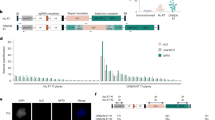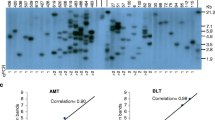Abstract
Transgenes in genetically modified plants are often not reliably expressed during development or in subsequent generations. Transcriptional gene silencing (TGS) as well as post-transcriptional gene silencing (PTGS) have been shown to occur in transgenic plants depending on integration pattern, copy number and integration site. In an effort to reduce position effects, to prevent read-through transcription and to provide a more accessible chromatin structure, a P35S-ß-glucuronidase (P35S-gus) transgene flanked by a scaffold/matrix attachment region from petunia (Petun-SAR), was introduced in Nicotiana tabacum plants by Agrobacterium tumefaciens mediated transformation. It was found that Petun-SAR mediates enhanced expression and copy number dependency up to 2 gene copies, but did not prevent gene silencing in transformants with multiple and rearranged gene copies. However, in contrast to the non-SAR transformants where silencing was irreversible and proceeded during long-term vegetative propagation and in progeny plants, gus expression in Petun-SAR plants was re-established in the course of development. Gene silencing was not necessarily accompanied by DNA methylation, while the gus transgene could still be expressed despite considerable CG methylation within the coding region.




Similar content being viewed by others
References
Allen GC, Spiker S, Thompson WF (2000) Use of matrix attachment regions (MARs) to minimize transgene silencing. Plant Mol Biol 43:361–376
De Buck S, Van Montagu M, Depicker A (2001) Transgene silencing of invertedly repeated transgenes is released upon deletion of one of the transgenes involved. Plant Mol Biol 46:433–445
De Buck S, Podevin N, Nolf J, Jacobs A, Depicker A (2009) The T-DNA integration pattern in Arabidopis transformants is highly determined by the transformed target cell. Plant J 60:134–145
De Neve M, De Buck S, De Wilde C, Van Houdt H, Strobbe I, Jacobs A, Van Montagu M, Depicker A (1999) Gene silencing results in instability of antibody production in transgenic plants. Mol Gen Genet 260:582–592
De Wilde C, Podevin N, Windels P, Depicker A (2001) Silencing of antibody genes in plants with single-copy transgene inserts as a result of gene dosage effects. Mol Genet Genom 265:647–653
Dellaporta SL, Wood J, Hicks JB (1983) A plant DNA minipreparation: version II. Plant Mol Biol Rep 1:19–21
Dietz A, Kay V, Schlake T, Landsmann J, Bode J (1994) A plant scaffold attached region detected close to a T-DNA integration site is active in mammalian cells. Nucl Acids Res 22:2744–2751
Dietz-Pfeilstetter A, Arndt N, Kay V, Bode J (2003) Molecular structure and regulatory potential of a T-DNA integration site in petunia. Transgenic Res 12:83–99
Ditta G, Stanfield S, Corbin D, Helinski DR (1980) Broad host range DNA cloning system for Gram-negative bacteria: construction of a gene bank of Rhizobium meliloti. Proc Natl Acad Sci USA 77:7347–7351
Eamans A, Wang M-B, Smith NA, Waterhouse PM (2008) RNA silencing in plants: yesterday, today, and tomorrow. Plant Physiol 147:456–468
Elmayan T, Vaucheret H (1996) Expression of single copies of a strongly expressed 35S transgene can be silenced post-transcriptionally. Plant J 9:787–797
Feinberg AP, Vogelstein B (1983) A technique for radiolabeling DNA restriction endonuclease fragments to high specific activity. Anal Biochem 132:6–13
Hetzl J, Foerster AM, Raidl G, Mittelsten Scheid O (2007) CyMATE: a new tool for methylation analysis of plant genomic DNA after bisulfite sequencing. Plant J 51:526–536
Hoekema A, Hirsch PR, Hooykaas PJJ, Schilperoort RA (1983) A binary plant vector strategy based on separation of vir- and T-region of the Agrobacterium tumefaciens Ti-plasmid. Nature 303:179–180
Horsch RB, Fry JE, Hoffmann NL, Eichholtz D, Rogers SG, Fraley RT (1985) A simple and general method for transferring genes into plants. Science 227:1229–1231
Inamdar NM, Ehrlich KC, Ehrlich M (1991) CpG methylation inhibits binding of several sequence-specific DNA-binding proteins from pea, wheat, soybean and cauliflower. Plant Mol Biol 17:111–123
Jefferson RA (1987) Assaying chimeric genes in plants: the GUS gene fusion system. Plant Mol Biol Rep 5:387–405
Kilby NJ, Leyser HMO, Furner IJ (1992) Promoter methylation and progressive transgene inactivation in Arabidopsis. Plant Mol Biol 20:103–112
Lam E, Benfey PN, Gilmartin PM, Fang RX, Chua NH (1989) Site-specific mutations alter in vitro factor binding and change promoter expression pattern in transgenic plants. Proc Natl Acad Sci USA 86:7890–7894
Lambe P, Dinant M, Matagne RF (1995) Differential long-term expression and methylation of the hygromycin phosphotransferase (hph) and ß-glucuronidase (GUS) genes in transgenic pearl millet (Pennisetum glaucum) callus. Plant Sci 108:51–62
Landsmann J, Llewellyn D, Dennis ES, Peacock WJ (1988) Organ regulated expression of the Parasponia andersonii haemoglobin gene in transgenic tobacco plants. Mol Gen Genet 214:68–73
Levin JS, Thompson WF, Csinos AS, Stephenson MG, Weissinger AK (2005) Matrix attachment regions increase the efficiency and stability of RNA-mediated resistance to tomato spotted wilt virus in transgenic tobacco. Transgenic Res 14:193–206
Lunerová-Bedřichová J, Bleys A, Fojtová M, Khaitová L, Depicker A, Kovařik A (2008) Trans-generation inheritance of methylation patterns in a tobacco transgene following a post-transcriptional silencing event. Plant J 54:1049–1062
Matzke M, Kanno T, Huettel B, Daxinder L, Matzke AJ (2007) Targets of RNA-directed DNA methylation. Curr Opin Plant Biol 10:512–519
Mette MF, van der Winden J, Matzke MA, Matzke AJM (2000) Transcriptional silencing and promoter methylation triggered by double-stranded RNA. EMBO J 19:5194–5201
Mlynárová L, Loonen A, Heldens J, Jansen RC, Keizer P, Stiekema WJ, Nap J-P (1994) Reduced position effect in mature transgenic plants conferred by the chicken lysozyme matrix-associated region. Plant Cell 6:417–426
Mlynárová L, Jansen RC, Conner AJ, Stiekema WJ, Nap J-P (1995) The MAR-mediated reduction in position effect can be uncoupled from copy number-dependent expression in transgenic plants. Plant Cell 7:599–609
Mlynárová L, Hricová A, Loonen A, Nap J-P (2003) The presence of a chromatin boundary appears to shield a transgene in tobacco from RNA silencing. Plant Cell 15:2203–2217
Mourrain P, van Blokland R, Kooter JM, Vaucheret H (2007) A single transgene locus triggers both transcriptional and post-transcriptional silencing through double-stranded RNA production. Planta 225:365–379
Muskens MWM, Vissers APA, Mol JNM, Kooter JM (2000) Role of inverted DNA repeats in transcriptional and post-transcriptional gene silencing. Plant Mol Biol 43:243–260
Napoli C, Lemieux C, Jorgensen R (1990) Introduction of a chimeric chalcone synthase gene into petunia results in reversible co-suppression of homologous genes in trans. Plant Cell 2:279–289
Nocarova E, Opatrny Z, Fischer L (2010) Successive silencing of tandem reporter genes in potato (Solanum tuberosum) over 5 years of vegetative propagation. Ann Bot 106:565–572
Oh S-J, Jeong JS, Kim E-H, Yi NR, Yi S-I, Jang I-C, Kim YS, Suh S-C, Nahm BH, Kim J-K (2005) Matrix attachment region from the chicken lysozyme locus reduces variability in transgene expression and confers copy number-dependence in transgenic rice plants. Plant Cell Rep 24:145–154
Okano Y, Miki D, Shimamoto K (2008) Small interfering RNA (siRNA) targeting of endogenous promoters induces DNA methylation, but not necessarily gene silencing, in rice. Plant J 53:65–77
Paulson JR, Laemmli UK (1977) The structure of histone-depleted metaphase chromosomes. Cell 12:817–828
Schubert D, Lechtenberg B, Forsbach A, Gils M, Bahadur S, Schmidt R (2004) Silencing in Arabidopsis T-DNA transformants: the predominant role of a gene-specific RNA sensing mechanism versus position effects. Plant Cell 16:2561–2572
Skårn M, Eike MC, Meza TJ, Mercy IS, Jakobsen KS, Aalen RB (2006) An inverted repeat transgene with a structure that cannot generate double-stranded RNA, suffers silencing independent of DNA methylation. Transgenic Res 15:489–500
Southern EM (1975) Detection of specific sequences among DNA fragments separated by gel electrophoresis. J Mol Biol 98:503–517
Teixeira FK, Colot V (2009) Gene body methylation in plants: a means to an end or an end to a means? EMBO J 28:997–998
Ülker B, Allen GC, Thompson WF, Spiker S, Weissinger AK (1999) A tobacco matrix attachment region reduces the loss of transgene expression in the progeny of transgenic tobacco plants. Plant J 18:253–263
Vain P, Worland B, Kohli A, Snape JW, Christou P, Allen GC, Thompson EM (1999) Matrix attachment regions increase transgene expression levels and stability in transgenic rice plants and their progeny. Plant J 18:233–242
Vaucheret H (2006) Post-transcirptional small RNA pathways in plants: mechanisms and regulations. Genes Dev 20:750–771
Vaucheret H, Elmayan T, Thierry D, van der Geest A, Hall T, Conner AJ, Mlynarova L, Nap J-P (1998) Flank matrix attachment regions (MARs) from chicken, bean, yeast or tobacco do not prevent homology-dependent trans-silencing in transgenic tobacco plants. Mol Gen Genet 259:388–392
Wang MB, Waterhouse PM (2000) High-efficiency silencing of a beta-glucuronidase gene in rice is correlated with repetitive transgene structure but is independent of DNA methylation. Plant Mol Biol 43:67–82
Zhang J, Lu L, Ji L, Yang G, Zheng C (2009) Functional characterization of a tobacco matrix attachment region-mediated enhancement of transgene expression. Transgenic Res 18:377–385
Zhao M, San Leon D, Delgadillo O, Garcia JA, Simon-Mateo C (2014) Virus-induced gene silencing in transgenic plants: transgene silencing and reactivation associate with two patterns of transgene body methylation. Plant J 79:440–452
Acknowledgments
We thank Heidi Vasterling and Tobias Wille for excellent technical assistance.
Author information
Authors and Affiliations
Corresponding author
Ethics declarations
Conflict of interest
The authors declare that they have no conflict of interest.
Electronic supplementary material
Below is the link to the electronic supplementary material.
Rights and permissions
About this article
Cite this article
Dietz-Pfeilstetter, A., Arndt, N. & Manske, U. Effects of a petunia scaffold/matrix attachment region on copy number dependency and stability of transgene expression in Nicotiana tabacum . Transgenic Res 25, 149–162 (2016). https://doi.org/10.1007/s11248-015-9924-2
Received:
Accepted:
Published:
Issue Date:
DOI: https://doi.org/10.1007/s11248-015-9924-2




